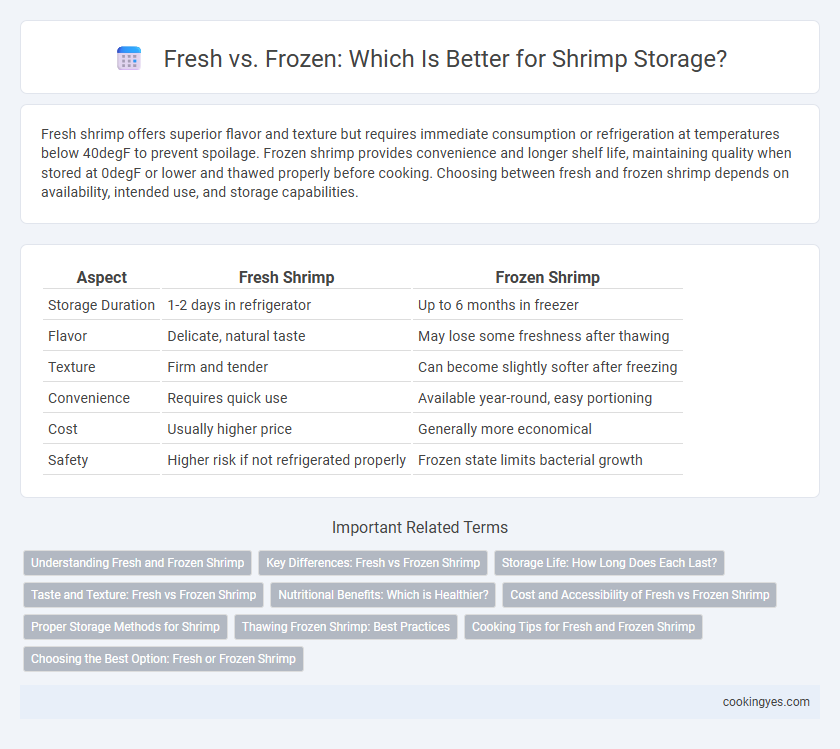Fresh shrimp offers superior flavor and texture but requires immediate consumption or refrigeration at temperatures below 40degF to prevent spoilage. Frozen shrimp provides convenience and longer shelf life, maintaining quality when stored at 0degF or lower and thawed properly before cooking. Choosing between fresh and frozen shrimp depends on availability, intended use, and storage capabilities.
Table of Comparison
| Aspect | Fresh Shrimp | Frozen Shrimp |
|---|---|---|
| Storage Duration | 1-2 days in refrigerator | Up to 6 months in freezer |
| Flavor | Delicate, natural taste | May lose some freshness after thawing |
| Texture | Firm and tender | Can become slightly softer after freezing |
| Convenience | Requires quick use | Available year-round, easy portioning |
| Cost | Usually higher price | Generally more economical |
| Safety | Higher risk if not refrigerated properly | Frozen state limits bacterial growth |
Understanding Fresh and Frozen Shrimp
Fresh shrimp offers superior texture and flavor due to minimal processing and rapid consumption after catching, while frozen shrimp undergo quick freezing to preserve nutrients and extend shelf life. Proper freezing techniques, such as flash freezing at -30degF (-34degC), prevent ice crystal formation that can damage shrimp muscle fibers, ensuring quality retention during storage. Understanding these differences helps consumers select shrimp based on cooking needs, storage duration, and desired taste experience.
Key Differences: Fresh vs Frozen Shrimp
Fresh shrimp offers superior texture and flavor due to minimal processing and immediate consumption after harvest, but it has a much shorter shelf life, typically lasting only one to two days when properly refrigerated. Frozen shrimp undergo a quick-freezing process that preserves the shrimp for months by preventing bacterial growth and enzymatic activity, maintaining safety and nutritional value but potentially compromising subtle texture differences. Both forms demand proper handling, with fresh shrimp needing cold, moist environments and frozen shrimp requiring consistent freezing temperatures to maximize quality and reduce spoilage.
Storage Life: How Long Does Each Last?
Fresh shrimp typically last 1 to 2 days in the refrigerator, while frozen shrimp can maintain optimal quality for up to 6 months when stored at 0degF (-18degC) or below. Proper packaging, such as vacuum sealing or airtight containers, extends frozen shrimp's shelf life by preventing freezer burn and preserving texture. Monitoring storage temperature is crucial to ensure freshness and safety in both fresh and frozen shrimp.
Taste and Texture: Fresh vs Frozen Shrimp
Fresh shrimp typically offer a sweeter, more delicate flavor and a firm, succulent texture, prized by seafood connoisseurs. Frozen shrimp, when properly flash-frozen at sea, retain much of their taste and texture but may experience slight changes due to ice crystal formation affecting cell structure. Proper thawing techniques can minimize texture degradation, making frozen shrimp a convenient and flavorful alternative to fresh.
Nutritional Benefits: Which is Healthier?
Fresh shrimp retain higher levels of essential nutrients like omega-3 fatty acids and vitamins compared to frozen shrimp, which may experience slight nutrient degradation during freezing and thawing. However, freezing shrimp shortly after harvesting helps preserve most of their nutritional benefits, preventing spoilage and extending shelf life. Choosing shrimp labeled as flash-frozen ensures maximum retention of proteins, minerals, and antioxidants, making it a healthy option when fresh shrimp is unavailable.
Cost and Accessibility of Fresh vs Frozen Shrimp
Frozen shrimp generally offer a lower cost per pound compared to fresh shrimp due to longer shelf life and reduced spoilage risks, making them more budget-friendly for consumers. Fresh shrimp availability is often limited by location and season, resulting in higher prices and less accessibility, especially inland or during off-peak periods. Frozen shrimp provide consistent quality and year-round availability, making them a practical and cost-effective choice for most buyers.
Proper Storage Methods for Shrimp
Fresh shrimp should be stored in the coldest part of the refrigerator at 32degF (0degC) and ideally consumed within 1-2 days to maintain optimal freshness and texture. Frozen shrimp must be kept at 0degF (-18degC) or below to preserve quality and prevent bacterial growth, with packaging airtight to avoid freezer burn. Proper thawing of frozen shrimp in the refrigerator or under cold running water ensures safe handling and minimizes texture degradation.
Thawing Frozen Shrimp: Best Practices
Thawing frozen shrimp involves placing them in the refrigerator overnight to ensure even temperature distribution and prevent bacterial growth. For quicker thawing, seal shrimp in a plastic bag and submerge them in cold water for 15 to 30 minutes, changing the water every 10 minutes. Avoid thawing shrimp at room temperature to maintain texture and flavor while minimizing food safety risks.
Cooking Tips for Fresh and Frozen Shrimp
Fresh shrimp should be cooked within 24 hours of purchase to maintain optimal flavor and texture, using methods like sauteing or grilling that highlight their natural sweetness. Frozen shrimp require proper thawing in the refrigerator overnight or under cold running water before cooking to avoid rubbery texture and ensure even heat distribution. Both fresh and frozen shrimp benefit from quick, high-heat cooking to preserve their delicate taste and prevent overcooking.
Choosing the Best Option: Fresh or Frozen Shrimp
Selecting between fresh and frozen shrimp depends largely on availability, quality, and intended use. Fresh shrimp offers superior texture and sweetness, best enjoyed soon after harvest, while frozen shrimp retains nutrients and flavor when properly flash-frozen shortly after catch. For long-term storage, frozen shrimp provides convenience and extended shelf life without significant loss of taste or nutritional value.
Fresh vs Frozen for shrimp storage Infographic

 cookingyes.com
cookingyes.com